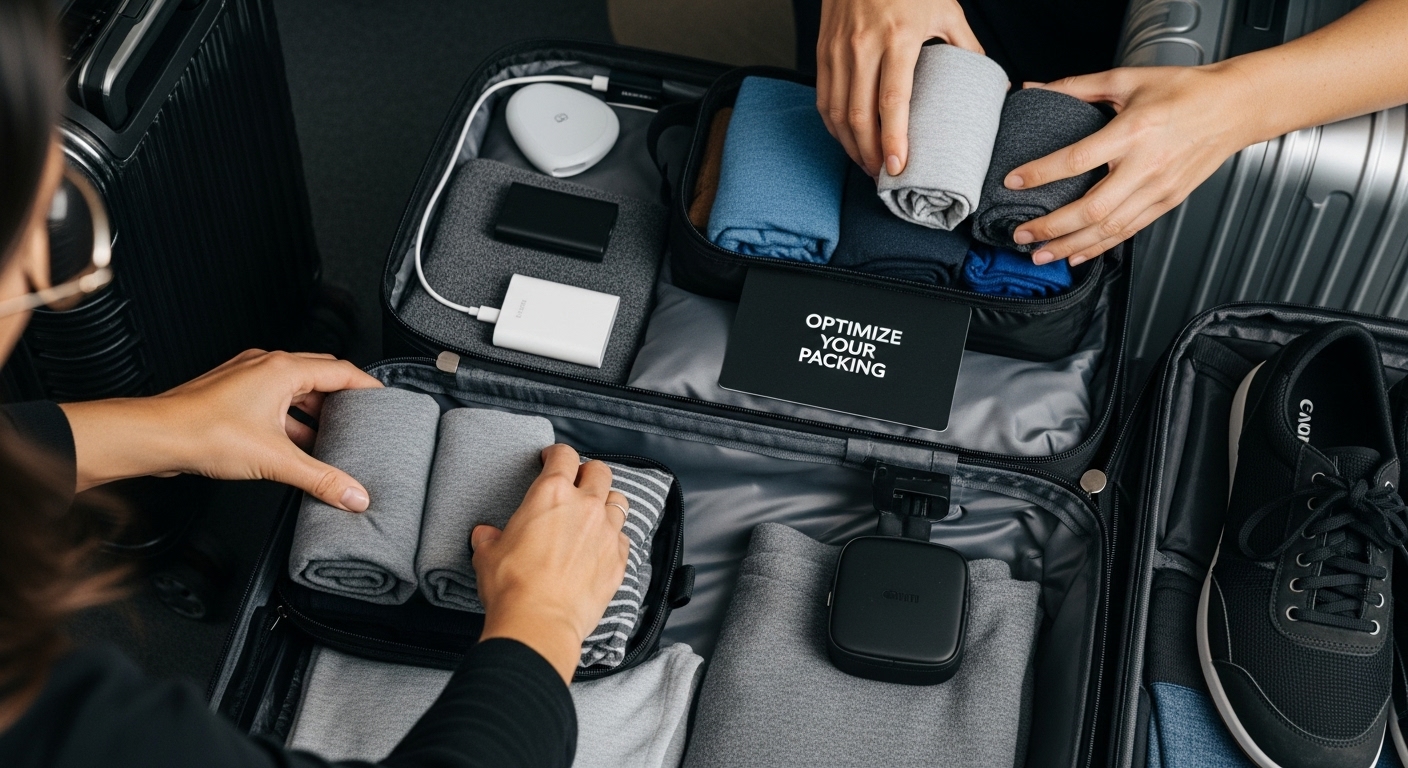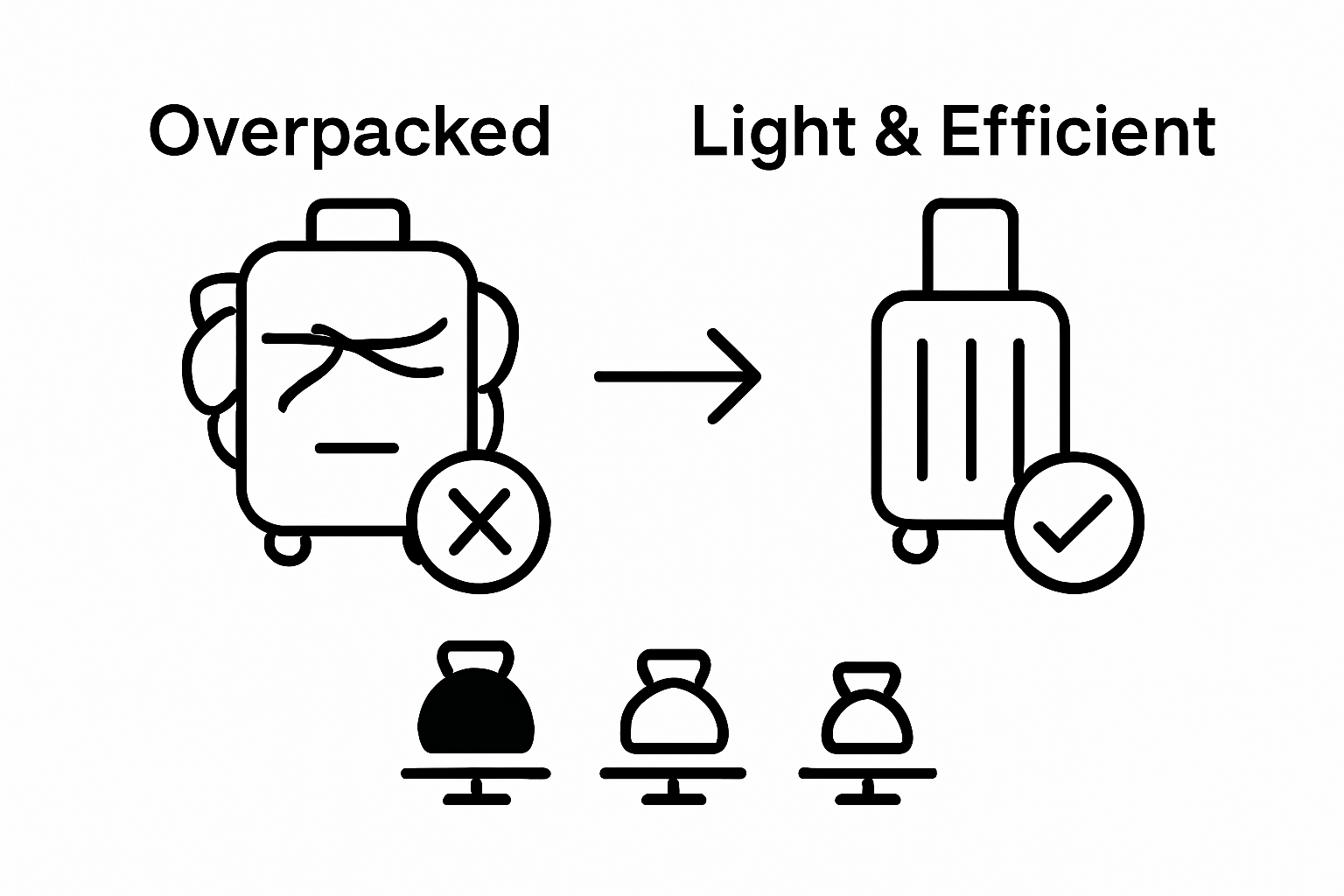Packing light sounds simple, but it is where most travelers stumble. Most people overpack, bringing nearly 40 percent more clothes than they actually wear. You might think the secret is in fancy luggage tricks or buying special mini-sized gear. The real key? It starts long before you even zip your bag, and it is all about ruthless planning.
Table of Contents
- Step 1: Assess Your Travel Needs And Duration
- Step 2: Choose Versatile Clothing Items
- Step 3: Select Compact Tech Accessories
- Step 4: Optimize Your Packing Process
- Step 5: Verify Your Packed Items And Weight
Quick Summary
| Key Point | Explanation |
|---|---|
| 1. Assess travel needs strategically | Analyze trip duration, activities, and climate to tailor packing effectively. Pack for approximately 75% of your trip length. |
| 2. Focus on versatile clothing items | Choose a core color palette and lightweight, multi-purpose clothing to maximize outfit combinations while minimizing total packed items. |
| 3. Select compact tech accessories | Prioritize multifunctional and lightweight technology that meets your needs, such as universal chargers and integrated devices. |
| 4. Optimize your packing process | Use packing cubes and rolling techniques to maximize luggage space, ensuring organization and ease of access during travel. |
| 5. Verify packed items and weight | Weigh your luggage and conduct an item audit to ensure that nothing unnecessary is included, maintaining a light and functional travel collection. |
Step 1: Assess Your Travel Needs and Duration
Successful light packing begins with a strategic assessment of your travel requirements. Understanding the nuances of your upcoming journey determines everything from the volume of clothing to the types of accessories you will carry. Your goal is to pack purposefully, not excessively.
Start by creating a comprehensive travel profile that captures the essential details of your trip. Consider the duration of your travel, the specific destinations, anticipated climate conditions, and planned activities. These factors will directly influence your packing strategy. For instance, a weekend business trip to a metropolitan area requires dramatically different preparation compared to a two-week adventure through multiple climate zones.
Carefully analyze your itinerary and break down the precise number of days you will be traveling. Count the exact days and plan your clothing and essentials accordingly. Pro tip: Plan to pack enough clothing for approximately 75% of your total trip duration, which allows strategic re-wearing and minimal luggage. Most travelers can effectively manage with a carefully curated wardrobe that mixes and matches versatile pieces.
Climate and destination-specific requirements play a crucial role in your packing decisions. Research the weather forecast for your destination during your travel dates. Will you encounter varying temperatures? Are there specific cultural dress codes or professional expectations? These considerations will help you select appropriate clothing and gear that serve multiple purposes while maintaining a lightweight approach.
Additionally, consider your personal comfort and functional needs. Check out our digital nomad checklist for insights into adaptable travel gear. Think about your daily routine, planned activities, and potential unexpected scenarios. Will you need specialized equipment for work, exercise, or specific recreational activities? Each item you pack should serve a clear purpose and contribute to your travel experience without unnecessary bulk.
Finally, create a preliminary packing list that reflects your travel assessment. Review this list critically, asking yourself: “Do I absolutely need this item?” Ruthless elimination is key to mastering light packing. Your ultimate objective is to craft a lean, efficient travel inventory that supports your journey without weighing you down physically or mentally.
Step 2: Choose Versatile Clothing Items
Versatile clothing is the cornerstone of successful light packing. Your goal is to create a travel wardrobe that maximizes outfit combinations while minimizing total items packed. Think of your clothing as a strategic system, not just individual pieces.
Begin by selecting a core color palette that allows seamless mixing and matching. Neutral colors like black, gray, navy, and white form an excellent foundation, enabling you to create multiple outfits with fewer individual pieces. This approach transforms your travel wardrobe into a modular system where each item can be paired with multiple others, dramatically expanding your outfit options.
Focus on lightweight, wrinkle-resistant fabrics that offer durability and quick-drying properties. Merino wool, technical synthetics, and performance blends provide exceptional versatility. A single well-chosen merino wool t-shirt, for instance, can serve as a base layer, standalone shirt, or workout top, and it naturally resists odors. Prioritize performance over pure aesthetics.
Select multi-purpose clothing items that transition easily between different settings. A lightweight blazer that works for both professional meetings and casual dinners eliminates the need to pack separate formal and informal jackets. Convertible pants that transform into shorts offer flexibility for varying climates and activities. Explore our digital nomad checklist for additional insights into adaptable travel gear.
Consider the layering potential of each piece. A thin, packable down jacket can provide warmth without consuming significant luggage space. Lightweight cardigans or thin sweaters offer temperature regulation and can dramatically extend the versatility of your core wardrobe. Remember that layers provide more flexibility than single, bulky items.
Develop a strategic clothing formula that limits your total pieces. A typical versatile travel wardrobe might include three tops, two bottoms, one jacket, and two pairs of shoes. This minimalist approach ensures you have sufficient clothing options while maintaining an ultralight packing strategy. The key is intentional selection, not deprivation.
Finally, test your clothing selections by physically laying out potential outfits and confirming their interchangeability. Each piece should connect with at least two other items in your travel wardrobe. This visual confirmation helps validate your versatile clothing strategy and ensures you’re truly prepared for your upcoming journey.
Step 3: Select Compact Tech Accessories
Navigating the world of tech accessories requires strategic selection that balances functionality with portability. Modern travelers need smart, lightweight solutions that maximize technological capability while minimizing physical bulk. Your goal is to curate a lean tech collection that supports your travel needs without weighing down your luggage.
Begin by identifying your core technological requirements. For most travelers, this means selecting a compact laptop or tablet, a multi-functional smartphone, and essential charging accessories. Focus on devices that serve multiple purposes and offer integrated features. A lightweight laptop with built-in cellular connectivity, for instance, eliminates the need for separate mobile hotspots and reduces overall device count.
Invest in universal charging solutions that work across multiple devices. Prioritize compact, multi-port USB chargers that can simultaneously power your smartphone, tablet, and other electronic devices. Look for international travel adapters with USB-C and USB-A ports, which provide maximum compatibility and reduce the number of individual chargers you need to pack. These versatile power solutions can dramatically reduce your technological footprint.
Consider innovative space-saving tech accessories. Our compact wireless keyboards represent an excellent example of minimalist design that doesn’t compromise functionality. Slim, foldable keyboards, portable power banks with multiple charging ports, and lightweight noise-canceling earbuds can provide essential technological capabilities without consuming significant luggage space.
According to a comprehensive study on international travel electronics, selecting compact, multi-functional devices is crucial for modern travelers. Choose technology that offers robust performance in a minimal form factor. A single high-quality smartphone with excellent camera capabilities can replace multiple devices like a standalone camera, GPS, and communication tool.
Protect your technological investments with minimal, lightweight solutions. Opt for slim, protective cases that offer durability without adding unnecessary weight. Consider integrated protective accessories like screen protectors and compact, padded sleeves that shield your devices while maintaining an ultralight approach.
Finally, conduct a final tech audit before packing. Verify that each technological item serves a clear, essential purpose. Remove any redundant devices or accessories that do not directly contribute to your travel productivity or enjoyment. Your ideal tech collection should feel like a carefully curated toolkit, not an overwhelming electronic library.
Step 4: Optimize Your Packing Process
Transforming your packing approach from chaotic to strategic requires a systematic method that maximizes space and minimizes complexity. The art of efficient packing lies not in how much you can squeeze into your luggage, but in how smartly you organize your items.
Start by selecting the right luggage that supports your light packing philosophy. A compact, carry-on sized bag with multiple compartments provides the perfect framework for organized travel. Look for bags with integrated compression systems and lightweight materials that don’t contribute unnecessary weight to your overall load. The bag itself should be a tool for efficiency, not an additional burden.
Master the rolling technique for clothing storage. Unlike traditional folding, rolling clothes creates compact cylinders that minimize wrinkles and maximize space. Tightly rolled garments can be strategically placed to fill every available luggage space, including shoes and gaps between larger items. This method not only saves space but also helps maintain the condition of your clothing during transit.
Utilize packing cubes as your organizational secret weapon. These lightweight containers transform your luggage into a modular storage system. Check out our business travel organization tips for advanced packing strategies. Categorize items by type or purpose: one cube for underwear and socks, another for shirts, a third for electronics accessories. This approach allows you to access specific items without disrupting your entire packing arrangement.
According to research from Stanford University, strategic layering is crucial for efficient packing. Place heavier items like shoes and tech accessories at the bottom of your bag, creating a stable base. Layer lighter clothing items on top, using the rolled technique. This method prevents crushing delicate fabrics and distributes weight more effectively.
Implement a strict one-in, one-out rule during packing. For every item you add to your luggage, remove something of similar size. This disciplined approach forces you to make intentional choices and prevents over-packing. Consider the versatility and necessity of each item with ruthless objectivity.
Finally, conduct a pre-travel packing audit. Lay out all items and critically evaluate each piece. Ask yourself: Does this item serve multiple purposes? Can I survive without it? Your goal is a lean, purposeful collection of travel essentials that support your journey without weighing you down physically or mentally. A successful packing process transforms luggage from a storage container into a carefully curated travel toolkit.

Step 5: Verify Your Packed Items and Weight
The final stage of light packing is a critical verification process that transforms your carefully curated collection into a travel-ready toolkit. Verification is not just about weight measurement, but about ensuring you have exactly what you need and nothing more.
Begin by weighing your packed luggage using a reliable digital scale. Invest in a compact, portable luggage scale that provides precise measurements. These small devices can be a traveler’s best friend, helping you avoid unexpected baggage fees and last-minute repacking scenarios. Your target weight should be significantly below airline or transportation limits, giving you flexibility and peace of mind.
Conduct a comprehensive item audit by laying out all packed items and cross-referencing them against your original packing list. This visual inspection allows you to identify any unnecessary items that might have slipped into your luggage during the packing process. Be ruthless in your assessment. If an item doesn’t serve a clear, essential purpose, remove it immediately.
Explore our business travel organization tips for additional strategies in streamlining your packing approach. Consider the practical functionality of each item. A single multi-purpose tool can often replace several specialized items, reducing both weight and complexity.
According to federal travel guidelines, accurate weight documentation is crucial for safe and efficient travel. Verify that your packed items comply with transportation regulations, particularly for electronic devices and potentially restricted materials. Create a mental inventory that you can quickly recall, ensuring you understand exactly what you’re carrying.
Test the mobility of your packed luggage before your trip. Walk around your living space with your fully packed bag, simulating actual travel conditions. Pay attention to how the weight feels, how easily you can maneuver the luggage, and whether any items shift uncomfortably during movement. This practical test reveals potential issues that might not be apparent during static packing.
Here is a quick-reference checklist you can use to verify that your luggage is lightweight, compliant, and travel-ready before you head out.
| Verification Step | Purpose | How to Complete |
|---|---|---|
| Weigh luggage | Ensure bags meet transportation limits | Use a digital luggage scale and compare to airline restrictions |
| Item audit | Eliminate unnecessary items | Lay out all items and cross-reference with your packing list |
| Compliance check | Confirm transportation regulation adherence | Make sure electronic devices and restricted items are allowed |
| Functional test | Test practicality and comfort | Walk around with packed bag and adjust for shifting or imbalances |
| Digital inventory | Keep records and backup for claims | Photograph bags and store a digital item list |
Finally, photograph your packed luggage and create a digital inventory of your items. This serves multiple purposes: documenting your packing for potential insurance claims, providing a backup reference if items are misplaced, and giving you a clear record of what you’re traveling with. Your goal is to create a lean, purposeful travel collection that supports your journey without becoming a logistical burden. A successful verification process means you’re traveling light, smart, and prepared for whatever your adventure brings.

Make Packing Light Effortless With Modern Travel Solutions
Tired of heavy bags and last-minute packing stress? Our guide, “How to Pack Light: A Step-by-Step Guide for Modern Travelers,” highlights how easily luggage can become a burden when your tech, clothing, and essentials are not portable or versatile. The constant struggle to organize chargers, streamline your wardrobe, and travel without unnecessary bulk can make any trip overwhelming. You deserve gear that keeps things simple and stylish.

Upgrade your travel experience today by building a lighter, smarter packing list. Explore Top Tech Accessories and Components, including compact power banks and wireless keyboards, or find Vacation Styles for Effortless Travel Fashion that maximize versatility. Visit Store42.co for the latest in tech essentials and functional apparel designed for mobile lifestyles. Start your best journey now and leave the weight behind.
Frequently Asked Questions
How can I start packing light for my trip?
Begin by assessing your travel needs, like duration, destinations, and activities. Create a packing list focusing on multi-purpose clothing and essentials while aiming for about 75% of your total trip duration in clothing.
What types of clothing should I pack for versatility?
Choose lightweight, wrinkle-resistant fabrics in a core color palette, allowing for easy mixing and matching. Items like merino wool and convertible pants offer flexibility across different settings and climates.
What tech accessories are essential for light packing?
Select compact devices that serve multiple functions, like a smartphone and a lightweight laptop. Prioritize universal chargers and multi-port adapters to minimize the number of items you pack.
How can I ensure my packed luggage is lightweight and organized?
Weigh your luggage using a digital scale and conduct a thorough item audit against your packing list. Utilize packing cubes and roll your clothing to maximize space, while ensuring that every item serves a clear purpose.

